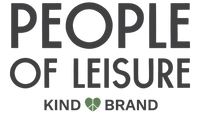In a world grappling with the environmental consequences of the fashion industry, many are looking towards the power of regenerative fashion. This transformative approach not only seeks to reduce harm but also aims to actively contribute to the regeneration of our planet.
To illustrate, regenerative fashion prioritizes a circular economy, sourcing materials responsibly, designing products for longevity, and implementing recycling or composting for end-of-life considerations to reduce waste.
Let's take a closer look at the power of regenerative fashion, exploring its core principles, its impact on the fashion and textile industry, and the role it plays in mitigating global challenges like climate change.
What is Regenerative Fashion?
At its essence, regenerative fashion signifies a departure from conventional practices that have long characterized the fashion industry. It encompasses garments crafted from fibers sourced from regenerative farms, reflecting a commitment to ethical, sustainable, and regenerative agriculture practices. The term "regenerative" extends beyond mere sustainability. It embodies a holistic philosophy that aims to restore ecosystems, promote biodiversity, and foster a symbiotic relationship between fashion production and the environment.
The Environmental Urgency: Mitigating Carbon Emissions
The fashion industry, notorious for its carbon footprint, stands as a significant contributor to global warming. Thankfully, regenerative fashion addresses this urgency by advocating for regenerative agriculture – a holistic farming approach that actively sequesters carbon in the soil, mitigating the industry's impact on climate change. By supporting regenerative practices, fashion brands can play a crucial role in reducing carbon emissions and fostering a climate-positive approach.
Organic Farming and the Importance of Soil Health
Central to regenerative agriculture is the practice of organic farming. Conventional agriculture often relies on synthetic pesticides and fertilizers, causing soil degradation and environmental harm. Regenerative farming, on the other hand, emphasizes cover crops, crop rotation, and the avoidance of harmful chemicals. These practices not only contribute to healthier soil but also enhance soil fertility, crucial for sustainable and regenerative textile production.
The Journey Towards Sustainable Fashion: Materials Matter
The shift towards regenerative fashion involves a reconsideration of the raw materials used in clothing production. Regenerative materials encompass substances sourced and manufactured to actively restore and enhance ecosystems, rather than deplete or harm them. Embracing a regenerative approach, these materials prioritize sustainability, environmental well-being, and social welfare throughout their lifecycle.
Here are some examples of regenerative materials:
Organic Cotton
Cultivated without synthetic pesticides and fertilizers, organic cotton fosters healthier soil and diminishes environmental impact.
Bamboo
As a rapidly renewable resource that grows without the need for chemicals, bamboo qualifies as a regenerative material when harvested sustainably.
Tencel/Lyocell
Obtained from sustainably sourced wood pulp, Tencel is produced in a closed-loop process, minimizing environmental harm.
Hemp:
Recognized for its versatility, hemp requires fewer pesticides and herbicides, establishing it as an environmentally friendly choice.
Recycled Materials:
Fabrics crafted from recycled plastic bottles, post-consumer waste, or repurposed textiles aid in waste reduction, supporting a circular economy.
Regenerative Agriculture Fibers:
Fibers cultivated through regenerative agricultural practices, such as rotational grazing, contribute to soil health and carbon sequestration.
Piñatex (Pineapple Leather):
Crafted from pineapple leaf fibers, Piñatex serves as a sustainable and cruelty-free alternative to traditional leather.
Incorporating regenerative materials into the fashion industry underscores responsible sourcing, minimizes environmental impact, and plays a role in fostering the overall well-being of ecosystems and communities involved in the production process.
Indigenous Land Stewardship and Regional Textile Systems
Regenerative fashion also underscores the importance of indigenous-led land stewardship. Recognizing the deep connection between indigenous communities and their land, this approach values the traditional wisdom and sustainable practices that have been passed down through generations.
Furthermore, regenerative fashion promotes regional textile systems, encouraging local sourcing of materials to reduce the environmental impact associated with long supply chains.
The Impact of Regenerative Agriculture on the Textile Industry
In the context of the textile industry, regenerative agriculture becomes a cornerstone for sourcing raw materials like cotton, wool, and other natural fibers. These fibers, cultivated in regenerative farms, not only produce textiles but actively contribute to the regeneration of the environment.
This shift towards regenerative agriculture aligns with the textile industry's increasing focus on ethical and sustainable sourcing, offering a pathway to cleaner and more responsible production processes.
As consumers demand greater transparency and environmentally conscious choices, regenerative agriculture emerges as a catalyst for positive change within the textile sector, paving the way for a more sustainable and regenerative future.
What is Regenerative Fashion's Impact on Local Biodiversity?
Regenerative farming practices actively promote local biodiversity by fostering ecosystems that support a vast diversity of plant and animal life. This emphasis on biodiversity is crucial for the health of our planet, contributing to ecosystem resilience and overall environmental balance. Furthermore, regenerative agriculture plays a pivotal role in carbon sequestration, trapping carbon dioxide in the soil and acting as a powerful tool against global warming.
The Role of Fashion Brands in Supporting Regenerative Agriculture
As the demand for sustainable practices grows, many fashion brands are recognizing the significance of supporting regenerative agriculture. By sourcing raw materials from regenerative farms, these brands contribute to the restoration of ecosystems, promote ethical farming practices, and align their supply chains with environmentally conscious principles. The Regenerative Organic Certification has emerged as a key standard, signifying a commitment to holistic sustainability across the fashion industry.
The Role of Consumers: Shifting Towards Sustainable Choices
In addition to embracing practices like thrifting and maximizing the use of your existing wardrobe, having a comprehensive understanding of the materials in your clothes empowers you to make informed choices during our shopping endeavors.
Brands that actively collaborate with regenerative farms are paving the way in the right direction. By supporting such brands, you can contribute to a fashion landscape that prioritizes sustainability, ethical sourcing, and a regenerative approach to clothing production.
Making mindful choices about the clothes you buy is not just a personal decision–it's a collective step towards a more environmentally conscious and ethically responsible fashion industry.
So, Is Regenerative Fashion Reshaping the Fashion Industry?
Regenerative fashion stands at the forefront of a profound transformation within the fashion industry, spurred by the escalating environmental awareness evident among both farmers and consumers. This shift towards conscious consumerism is reshaping the landscape, compelling brands to gradually adopt sustainable methods and processes promoting fair trade.
As a result, there is a discernible movement towards providing ethically crafted and sustainable apparel that aligns with the values of socially and environmentally responsible consumers.
The momentum observed in the increasing adoption of regenerative fashion suggests a transformative trajectory. The trend of regenerative fashion, fueled by a collective commitment to ecological responsibility, indicates that regenerative fashion is poised to dominate the market in the coming decades.
As consumers continue to prioritize sustainability and ethical considerations in their purchasing decisions, the fashion industry is compelled to undergo a lasting metamorphosis, with regenerative practices at its core. This evolving paradigm not only redefines the products available but also sets a new standard for the industry, emphasizing the enduring impact of conscious consumer choices on the future of fashion.
Our Commitment to Regenerative Fashion
In recognizing the environmental impact of clothing production, we're dedicated to sustainable practices and global well-being. One way we do this is by prioritizing sustainability in our material selection.
For example, our conscious choice to incorporate both organic cotton and hemp in our production reflects our dedication to minimizing the ecological footprint of our garments. Additionally, our commitment extends to reducing waste and conserving resources.
We do this by actively purchasing deadstock fabric that would otherwise end up in landfills. By upcycling this fabric, we contribute to the circular economy, mitigating the need for additional land, water, energy, and soil use in our production processes.
The Bottom Line
As a response to the pressing environmental challenges we face, regenerative fashion offers a path towards a more sustainable, ethical, and regenerative future. By embracing regenerative practices, supporting local ecosystems, and prioritizing ethical sourcing, the fashion and textile industry can become a catalyst for positive change. In the journey towards regenerative fashion, every stakeholder–from fashion brands and farmers to consumers–plays a crucial role in shaping a future where the fashion industry becomes a regenerative force for the planet and its inhabitants.






